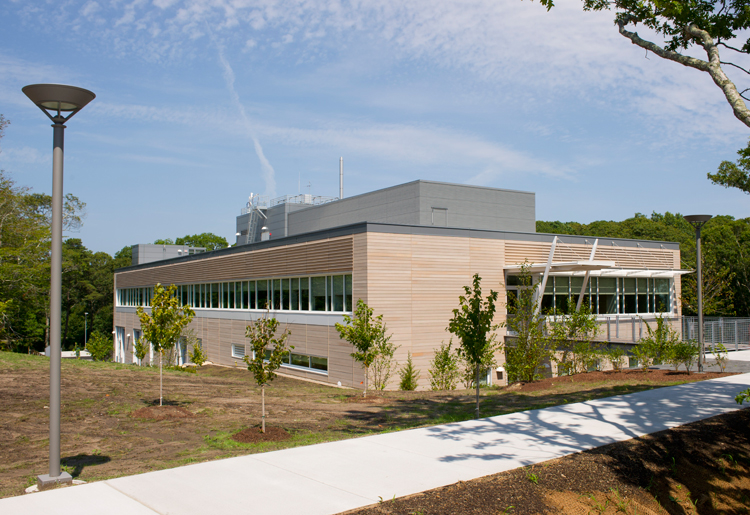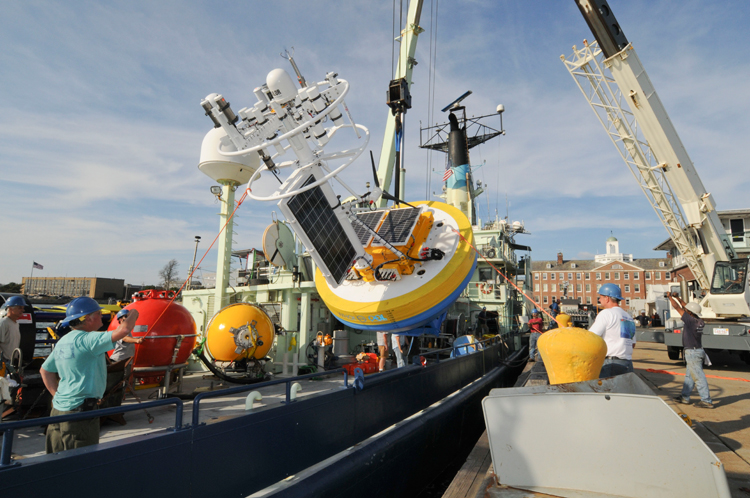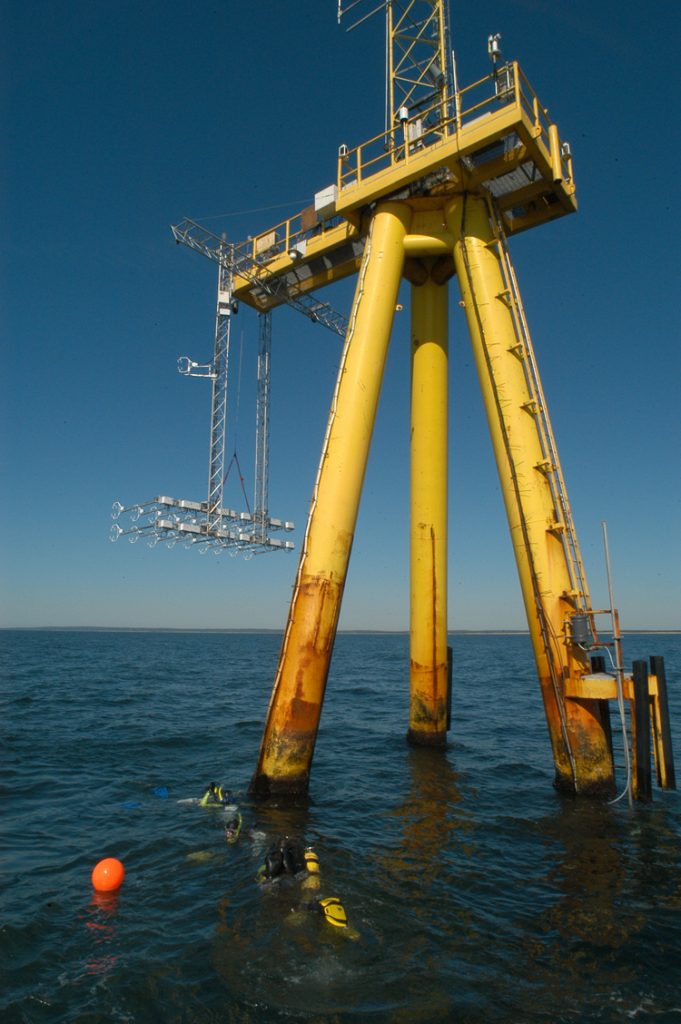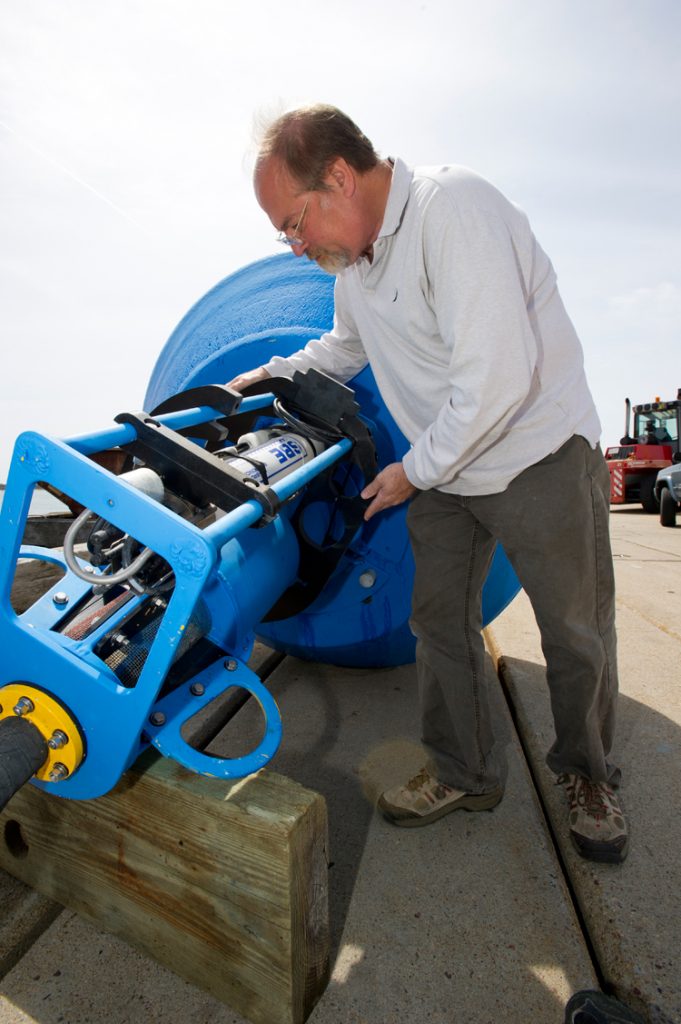Dedication Ceremony Held for New Laboratory
WHOI President and Director Susan Avery and Director of Research Larry Madin were joined by National Institute of Standards and Technology (NIST) Associate Director for Laboratory Programs and Principal Deputy Willie May at a dedication ceremony Sept. 20 for the new Laboratory for Ocean Sensors and Observing Systems. The ceremonial ribbon cutting took place by the state-of-the-art facility’s high bay entrance, located on the Institution’s 180-acre Quissett campus.
WHOI received an $8.1 million grant from NIST in 2010 to fund construction of the new scientific research facility, as part of the American Recovery and Reinvestment Act. WHOI contributed $4 million to the project. The 26,000-square-foot, “green”-designed building will provide space for a major effort to create long-term ocean observatories.
“This is an incredible day for the Oceanographic Institution,” said Avery. “Thanks in large measure to the National Institute of Standards and Technology, which had faith in the important ambitions in our proposal, we now have 26 thousand square feet of new space for science and engineering activities that have already begun to define the future of how we observe and learn about the ocean.”
NIST is one of the nation’s oldest physical science laboratories with a mission to promote US innovation and industrial competitiveness by advancing measurement science, standards, and technology in ways that enhance economic security and improve our quality of life. NIST support for cutting-edge ocean science and technology development is helping ensure that WHOI, and the United States, remains in the forefront of science, which will in turn be used to advance economic growth, our nation’s international competitiveness.
“I am thrilled to share in the excitement and the expectation of the great advances, the scientific achievement, and the public good that will result from this facility,” said May, noting that WHOI was one of 12 proposals NIST funded from a pool of 167. “Science progresses more or less in lock step with our ability to measure the world around us, and the ocean is the new frontier in measurement science. The work in this new laboratory using sensors to measure ocean conditions and processes will certainly be key to our understanding of many of the challenges facing our nation such as drought and floods, marine resource management, and climate change.”
The Laboratory for Ocean Sensors and Observing Systems (LOSOS) houses researchers working on the Ocean Observatories Initiative (OOI), a multimillion-dollar effort funded by the National Science Foundation to build and operate a network of moored buoys, undersea cabled networks, sensors, and autonomous underwater vehicles over the coming decades. The OOI network will provide real-time, 24/7 data to researchers working to understand climate variability, ocean circulation and ecosystem dynamics, air-sea exchange, seafloor processes, and plate-scale geodynamics. WHOI is leading the coastal and global scale nodes of the OOI, and its team occupies most of the building, including the central high bay, built to accommodate tall buoys and with a 10-ton capacity bridge crane for hoisting them.
Three other programs share the building:
- The Martha’s Vineyard Coastal Observatory (MVCO) operations group, which has maintained a cabled underwater ocean-observing facility at the island since 2001.
- The National Ocean Bottom Seismograph Instrument Pool (OBSIP), which builds seafloor instruments to detect undersea earthquakes, volcanoes, landslides and other ground-shaking events.
- The Environmental Sample Processor (ESP) program, which deploys new robotic underwater labs-in-canisters. ESPs detect microscopic marine organisms, including harmful algae and their toxins, and transmit information in near real time to scientists ashore.
Tailored to occupants’ specific needs, the facility includes a 15-foot-long tank to allow instrument ballast tests; access pathways to the roof for cables that will carry high-bandwidth data via satellite from deployed instruments; and, in the OBS testing lab, a granite floor slab entirely separated from the rest of the building for testing the seismic instruments without exposure to the vibrations a building produces. Among other features, the building also includes a high-pressure washing station to be used on observing system components recovered from the ocean and cleaned before re-deployment. The water station will reclaim, filter, and capture runoff liquid and debris before it seeps into surrounding land.
LOSOS is WHOI’s first LEED (Leadership in Energy and Environmental Design)-certified laboratory. LEED ratings, developed by the U.S. Green Building Council, assess buildings for materials and methods that foster human and environmental health. Wide-ranging features in the new lab, designed by Ellenzweig of Cambridge, Mass. and built by Columbia Construction Company of North Reading, Mass, contribute to sustainability and efficiency.
“We expect to achieve the LEED Gold certification pending final review by the USGBC,” says WHOI Director of Construction Projects Ernie Charette.
The building incorporates efficiencies, from the 95 percent combustion efficiency boilers, to radiant-heat flooring in the high bay, to energy-saving fluorescent lights directed upward for diffuse, eye-friendly illumination. Ultimately, these enhancements add up to 13 to 14 percent more energy-efficiency than a traditional building.
Scientists and engineers began moving into the new lab in August, the first realization of a goal to bring different ocean-observing groups under one roof, to more easily share and cross-fertilize ideas, and spur innovation.

(Photo by Tom Kleindinst, Woods Hole Oceanographic Institution)

(Photo by Tom Kleindinst, Woods Hole Oceanographic Institution)

(Photo by Jayne Doucette, Woods Hole Oceanographic Institution)

(Photo by Jayne Doucette, Woods Hole Oceanographic Institution)

(Photo by Tom Kleindinst, Woods Hole Oceanographic Institution)